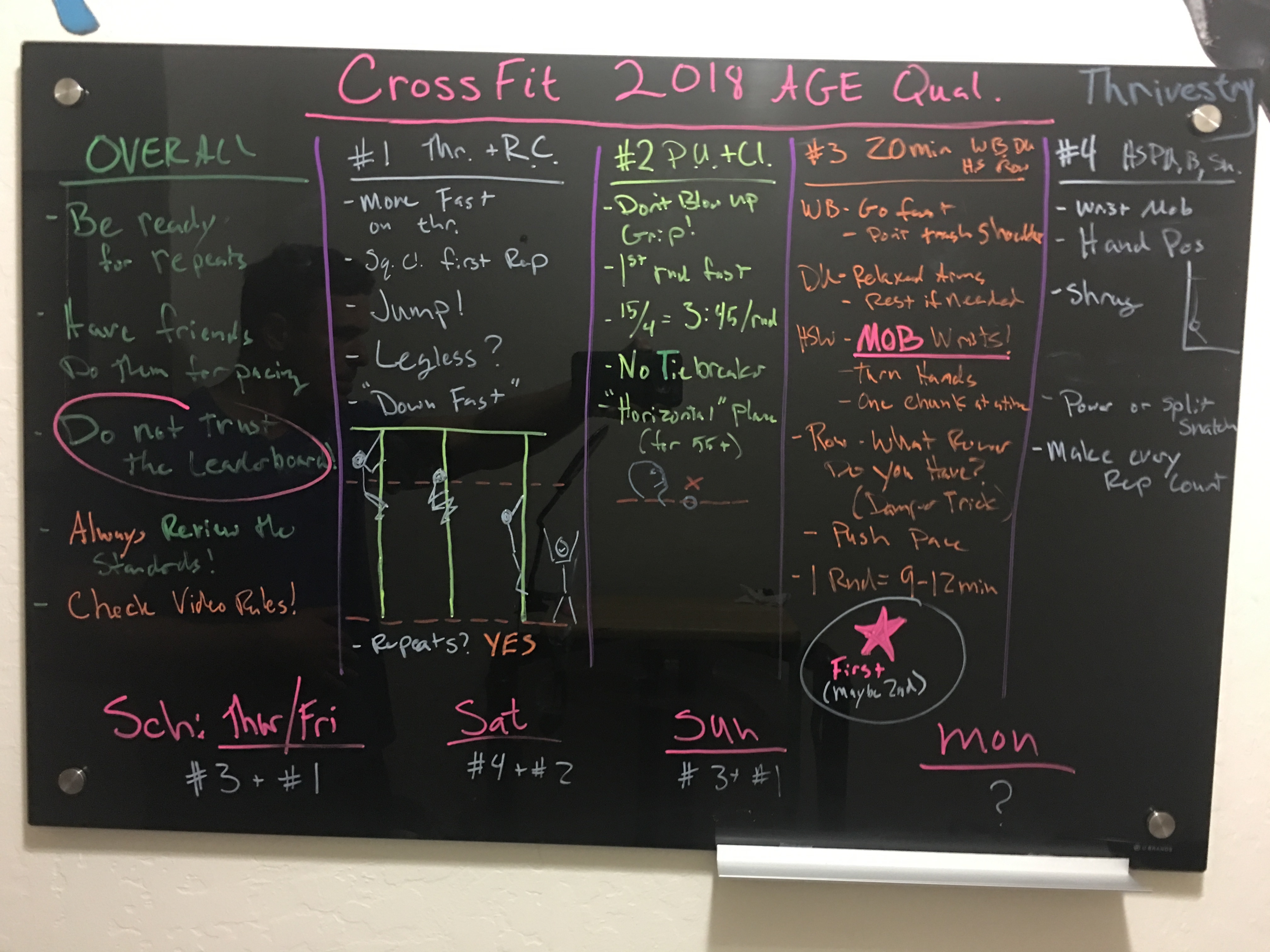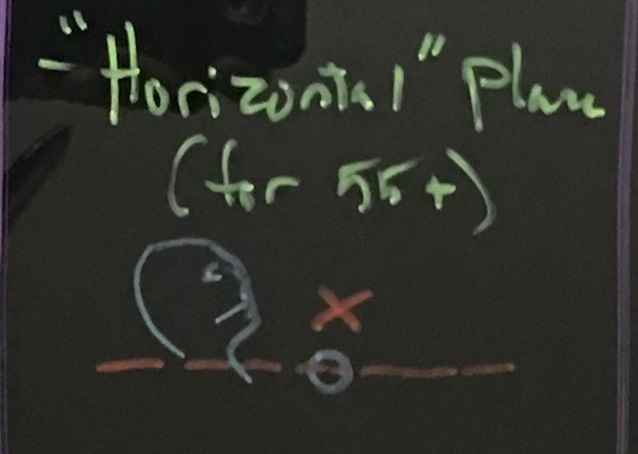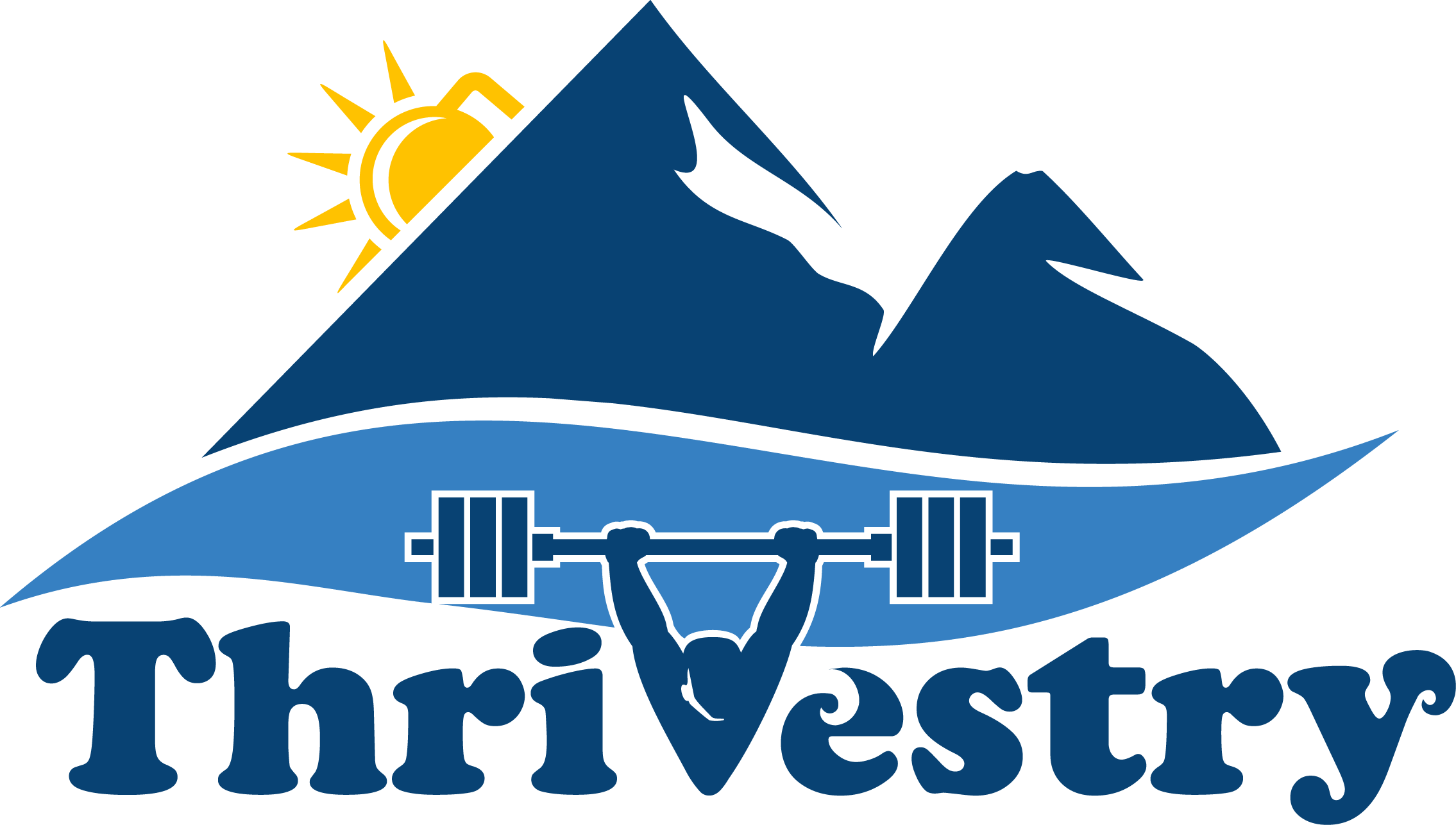CrossFit 2018 Online Age Qualifer Breakdown and Tips
CrossFit did not disappoint this year with the workouts! Wow! Not a ton of things for the bodyweight folks and no single heavy lift, but a lot of heavy stuff and rope climbs to boot!
Overall
Watch the video for the full run down. I am going to only hit the high points here since I am covering all four workouts.
Be ready for repeats! This is not the time to do a ‘one and done’ approach. This is the time to make every increment possible count!
Have ‘friends’ do the workout before you to get information on how to do it better. If you know other masters (especially in other age brackets) trade scores with the so you know where your scores are likely to land you.
Do not trust the leaderboard. Any scores that do get posted will not likely be where folks end up (they’ll probably do it more than once).
ALWAYS review the standards. Do not assume you know the standard because you did it in previous years. Make sure you do it right the first time.
Video every workout according to the rules for videoing (even if you don’t think you are going to make the Games this year). It will be good to review the ‘game film’ for your later attempts, and it is good practice for next year. Having a good video will also make sure you don’t have to repeat a workout when they ask for it!
This year has some significant grip work. Make sure you are taking care of your wrists so that you have good range of motion for those handstand walks and HSPU. Try to get these workouts done before you blow your grip up with lots of pull ups and rope climbs.

#1 Thrusters and Rope climbs (4-8-12 and 1-2-3) 10-minute time cap.
Thrusters
Squat clean the first rep if you can, then try and do each set unbroken. If you must rest, rest at the overhead position or at the shoulder without dropping the bar. Move fast and make sure every rep counts.
Rope Climbs
Jump up for each rep!
If you can do legless efficiently (like we practice a lot in the Thrivestry Programming), consider using this technique to move faster than using your legs (even if you only do the first rep of each round legless).
One of the keys to going faster on this workout is getting down on rope climbs (Check out the video for more information). When using your feet, the best descent technique is to ‘squat’ down and grab the rope near or below your knees. This should be below the 11 foot line. After grabbing, let your feet go and then hang with a straight body below the mark (showing control). You should be able to drop to the floor from here. Shorter athletes may need to do this 2 times (squat, grab, squat, grab, drop), but most people won’t have an issue with one. Practice this ahead of time to really maximize the faster technique without paying any extra ‘energy’ penalty!

Pacing and Repeats
This is one that can probably be done 2-3 times without too much effect on the body. If you mess up your rope climbs, do it again!
Fast times for this will be in the 2 – 3 minute range (maybe less)!
#2 Pull ups and Cleans (25 reps and then 5 reps at 245/170) 15-min time cap
Pull ups
Go big on your first set of pull ups, but don’t blow up your grip! You need to be rested enough to go right into that first clean rep. Consider breaking it up one or two times (with minimal rest). This will pay off in the later rounds when you can keep doing decent sized sets.
If you can do butterfly pull ups, and they don’t trash your grip, do them! Remember to use a lot of legs and hips to get your body high and avoid pulling with the arms as much.
If you are doing ‘chin over bar’ pull ups, remember that the standard is ‘above the horizontal line of the pull up bar’. Your chin DOES NOT need to go above the bar (breaking the vertical plane). Imagine that the top of the bar is the surface of water, you need to get your head completely out of the water for the rep to count.

Cleans
If this is near your max, take your time on the pull ups and make sure you are ‘fresh’ for that first set of cleans. If you have never cleaned this amount (but are reasonably close), take a few minutes to get through those pull ups, and then rest a minute or two before your first attempt.
If you are confident you can do these (in a strength workout with 2s or 3s for example), push the pace on the pull ups a bit (on the first round), and then try to get some steady singles in. Pace the following rounds of pull ups so that you aren’t rushing to the barbell again without enough rest to get the weight up efficiently.
There is no tie breaker, so pace the workout to get the most reps or finish (as opposed to pushing to finish the pull ups fast, risking a no-rep on the cleans).
If you can do these well (maybe able to link 2 or 3 in a row, fresh), you’ll still want to do singles for the most part. Go faster on the pull ups, and save some gas for the last round of pull ups and cleans.
Pacing and Repeats
To finish right at 15 minutes means you’ll have to do about one round every 3:45. If you do the pull ups in 90s, you’ll have 2:15 to get through the cleans.
Fast times for this will be in the 6 – 9 minute range (about a minute or less for the pull ups and a minute or less for the cleans), but there will be a lot of folks with zero cleans or just one round of cleans and 2 rounds of pull ups. If this is a heavy weight for you, pace to get as many reps as possible!
#3 Wall ball, Double Unders, HS Walks, Rowing – 20-minute AMRAP
50 wall ball, 100 DU, 50’ HS walk, 100 DU, 50 Cal Row, 100 DU, 50’ HS walk, 100 DU
That is 200’ of handstand walking and 800 double unders if you complete two rounds!
The one BIG point I want to make here is that this workout will be a lot harder if your forearms are messed up from doing tons of chest to bar pull ups and rope climbs (and snatches for that matter). Get your attempts with this one done early so you aren’t failing on HS walks because you don’t have good wrist flexion!
Wall Balls
Go fast on the first round, but use as little shoulders as possible so you aren’t as fatigued for the HS walks and double unders. If you are tall enough, avoid extending your arms out as far as possible. Use the ‘wrist flick’ technique (outlined in the video) to be more efficient.
Double Unders
You may want to go big on your first set, but if you learned that this didn’t work for you in the Open, don’t repeat your mistakes here. Pace these so you can ‘meter’ the intensity and avoid blowing up your shoulders for the HS walks. If you mess up (because you tripped, not because you were tired), do not rest excessively, get right back to it!
Keep your arms close to your sides and your shoulders relaxed. Tense arms will make the HS walks much harder!
Handstand Walks
Make sure you start your HS walks behind the line so you don’t get no-repped!
The key to HS walks is to get your center of mass (aka center of balance) past your hands so you can make forward progress. Having good shoulder mobility and wrist mobility will really pay off here. As noted above, spend some extra time mobilizing your wrists so you have better control.
If you have wrist mobility issues, you can turn your fingers to the outside so that the web of your hand is going toward the direction of travel. You will lose balance and control, but you will be able to move forward without falling or wrenching your wrists.
For those folks who can’t do handstand walks effectively… This is a 20 minute workout. If you can do 5 or 10 feet at a time, quickly, you will still be able to get fairly far on this workout. You can make up time on the other movements by going faster on those, and ‘recovering’ during your short handstand ‘shuffles’. Kick up and get that center of balance going the right direction. Take fast steps with your hands so that you can cross the line (5 feet will be 5 – 8 ‘steps’). Cross the line and then come down (fall if you have to). Reset and go again. If you plan on falling down a lot, make sure you are on a forgiving surface, or that you are wearing some sort of protection!
Row
Experiment with the rower to see if you do better with the damper set at 1 and doing slow strokes per minute (but hard) pulls. Some rowers seem to do better with this technique when measuring calories (your ‘mileage may vary’).
If this doesn’t play a large role for you, plan on going a bit hard on this row (2-3 minutes for taller folks. 2:30-3:30 for everyone else). If you push the pace, you’ll end up doing less total work.
Pacing and Repeats
As long as you don’t get too caught up by the handstand walks, you should be able to finish a round in 9-12 minutes. The second round you will want to pace the wall balls a bit more, and plan your double unders so that you can still do HS walks effectively.
Try to get this one (and it’s repeats) earlier on due to the grip and wrist flexion issue. If your grip is blown up from the other workouts, you will have a much harder time doing handstand walks!
If you get deep into the second round (or farther), I wouldn’t do this one more than twice. Those double unders will really take a toll. If you keep getting stuck on the HS walks, 3 times isn’t out of the question!
#4 9 Handstand Push ups, 6 bar facing burpees, 3 snatches (165/115), 5-minute AMRAP
Handstand Push Ups
Make sure your wrists are mobilized, and that you mark where your hands need to be to meet the standards. Pull your toes to your knees to get those heels up over the line. Make the body a straight line so that you aren’t ‘kinked’ at the hip or shoulder. Emphasis the ‘shrug’ in the shoulders so that you are getting every inch of height.
These will probably be the key to this workout. Make sure you are in good communication with your judge so that you know when your rep is ‘good’. Make every rep count! This is a short workout, and you can’t afford faults!
Each round, you’ll probably fly through the other movements. Take a bit of time to make sure these are ‘clean’, and that every rep is solid. Try to do these unbroken for the beginning rounds, then break them up if/when you need a bit of rest (doing 5/4 or 6/3). As soon as you finish them, go right into a fast set of burpees.
Bar Facing Burpees
Move fast on the burpees, but make sure you meet the standards of no stepping back or up, and a two footed jump and landing. If you can avoid ‘pressing’ with the arms (by rocking your body like a rocking chair), do it. Saving the shoulders will make HSPU easier on later rounds.
Snatches
While I wouldn’t consider these ‘light’ snatches, there is only 3 reps per round. Touch and go them if you can. Fast singles if you can’t. Make sure you aren’t pressing them out (do a power snatch squatting low enough to catch with straight arms, or a split snatch with straight arms as well).
Order
I believe that doing #3 earlier on is going to be good, especially if you struggle with wrist flexion and handstand walks. Do #3 and #1 on Thur/Fri. Saturday should be your day when you do #4 first (so your forearms aren’t as jacked) then do #2. Sunday will be the day to repeat #3 and #1 (and likely #4 and #2 on Monday)
That said, if you aren’t going to be doing a lot of chest to bar pull ups (because the clean is heavy), you may want to change the order a bit. Do #2 before you do #4 on Saturday (or even get it out of the way on Friday in lieu of doing #1)
Monday will be the day where you repeat 2 or 3 of the workouts (#1, #2, or #4 most likely). This will depend on how you performed on the first go throughs.
Mindset
Even though you will likely repeat most of these, have a good plan and execute as if this is your only chance. Don’t start to slow down when things go wrong or you start to get frustrated. Having other people do this one with you (even if they scale) will help you push faster than if you go alone.
And as I have said in other Breakdowns, this is the end of the Open. It is another year (or your first year) in the books. While you may look forward to moving on and getting back to regular training, it is important that you gleam every drop of experience that you can.
Journal what went right this year and what went not-so-right. How could you have been better prepared? Paste these notes onto you calendar for reminders 2-3 times over the next year so that you can keep your routines focused on improving for next year.
No matter where you finish, remember that you are either winning, or LEARNING. Even if you didn’t finish as high as you’d liked to, you have earned some experience that you wouldn’t have got any other way. You are better no matter what place you finished.
Afterward, spend the next few weeks doing activities that you enjoy (in an outside of the gym). Recharge and get ready for the next big challenge!
Thrive on.
-jj

0 comments
Leave a comment